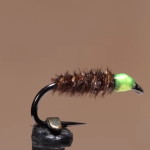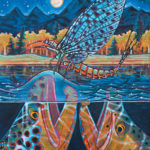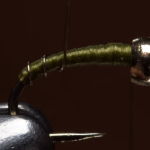Rat Facts
It turns out that supersized rodents inhabit most of the world. They are excellent swimmers, and some can hold their breath for up to three minutes! This got me thinking about how to design a first-rate rodent.
The hook shank for this royal rat imitation had to be large enough to accommodate a long, fluffy body. The hook should also have a wide gap and formidable strength. I tested several long-shank hooks, and after successfully pounding a size 2/0 Mustad into a dock pile and leaning on it with my 10-weight rod, I knew I had the winner.

To help ensure the durability of the new fly, I lashed all the materials to the hook using Kevlar thread; Kevlar is the same material used in bulletproof vests. Nothing withstands piranha attacks forever, but Kevlar thread would certainly help.
The body material needed to be soft enough to lie back and not flare when spun in a dubbing loop, and it needed to be long enough to wrap a realistically shaped body without cutting off the tips of the fur. Whenever possible, I choose natural materials, and the texture, length, and color of coyote fur were exactly what I needed. Coyote fur also quickly sheds water after just one or two false casts, allowing the fly to have an extremely large profile yet remain light and aerodynamic for hours of accurate casting.
Where the fly hangs in the water column, along with how it moves when stripped, is also very important. I managed to find some videos of real swimming rats, and I was amazed at how quickly and efficiently they move through the water using their tails as rudders while dog-paddling with their front legs. Their faces usually remained out of the water, so the head of my new fly needed to ride higher and be considerably more buoyant than the body.
Tying the Body & Head
When motionless, a rat’s thin, soft hair undulates in the current, making it look like a large meal to a game fish. In order to achieve the desired result, I substituted the usual leather or felt ears for 3-millimeter-thick foam, and I added more buoyancy by fashioning the head using tightly packed strips of foam. To beef up the fly’s durability and realistic appearance, I substituted a piece of ridged paracord for the supple rabbit Zonker-strip tail.
Paracord can take much more abuse from piranhas and other toothy game fish, and the inherent stiffness of the material keeps it from fouling around the hook. I chose pink paracord because it is somewhat natural looking, and it is easy to see in the water at great distances. This is key for tracking the fly and ensuring that you don’t miss a strike. After days of torture-testing and tweaking the pattern, getting fish to eat it was no longer a problem; getting them to stay on the hook, however, was more of a challenge.
![]()
After nearly half a dozen dorado came unbuttoned from the fly, I put the microscope on the most crucial element of this pattern—the weed guard. The classic bass-bug weed guard—a double loop of monofilament running down the bend of the hook and back to the hook eye—looked great, but it was counterproductive when fishing. I changed the weed guard to a double post of 30-pound-test Mason hard monofilament.
I tested the pattern for two more days, dragging it over islands of grass and lily pads throughout the marsh. A ferocious strike typically occurred when the fly hopped off vegetation into the water with an audible plop. Each fly was rigged with a complicated wire leader, so I fished each one until it was almost unrecognizable; after five or six dorado, your rat will look like something a cat regurgitated. If northern pike or muskie are more your game, you can create tough flies for these toothy predators using the same tying methods.
Adding the Weedguard
While field-testing the new pattern, Francois Botha, a guide at Pirá Lodge, named it the King Rat. I thought the double meaning was perfect: this term is used to describe an abnormally large rat, and South American anglers say that a “king rat” is a rat that is so large, cats flee when they see it.
Do you cast to large, nasty predators? The King Rat will tame even the meanest fish.
Drew Chicone is turning on the fly tying world with his unique fish-catching patterns. He is also a first-rate fly tying and angling instructor. To learn more, go to his websites, www.stripstrikeuniversity.com and www.saltyflytying.com. Drew lives in Florida.








